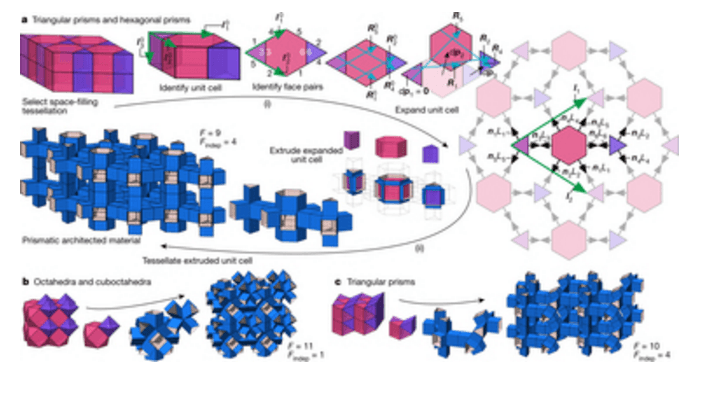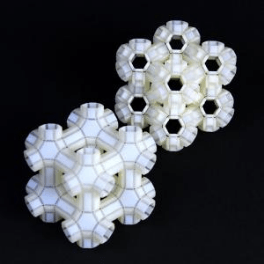Harvard SEAS & Wyss Institute Researchers Experiment with Multifunctional Metamaterials
 While most of us have just gotten used to the wonders of 3D printing, a number of researchers have already moved far beyond that into the realm of the fourth dimension, with materials that are able to morph according to their environment. We’ve reported on this complex new technology from biomimetics to 4D scanning and much more—often to include intuitive apparel.
While most of us have just gotten used to the wonders of 3D printing, a number of researchers have already moved far beyond that into the realm of the fourth dimension, with materials that are able to morph according to their environment. We’ve reported on this complex new technology from biomimetics to 4D scanning and much more—often to include intuitive apparel.
Now, researchers at the Harvard John A. Paulson School of Engineering and Applied Sciences (SEAS) and the Wyss Institute of Biologically Inspired Engineering at Harvard University are creating metamaterials that function in multiple ways, and can switch back and forth between uses. While the use of metamaterials is no longer a novelty, researchers wanted to expand their abilities beyond what has even been seen, allowing these textures not just to switch from one function to another, but to do so autonomously.
The research teams have created these metamaterials to work on any scale, from very large to very small. This is all outlined in their recent paper, ‘Rational design of reconfigurable prismatic architected materials,’ authored by Johannes T. B. Overvelde, James C. Weaver, Chuck Hoberman, and Katia Bertoldi.

Space-filling and periodic assemblies of convex polyhedra are. used as templates to construct prismatic architected materials
“Given that the underlying principles are scale-independent, our strategy can be applied to the design of the next generation of reconfigurable structures and materials, ranging from metre-scale transformable architectures to nanometre-scale tunable photonic systems,” state the researchers in their paper.
The metamaterials design project came about in 2014 as Katie Bertoldi, senior author on the paper and a John L. Loeb Associate Professor of the Natural Sciences at SEAS, began working with graduate student Johannes Overvelde, first author on the paper, and Chuck Hoberman, of the Harvard Graduate School of Design (GSD) and associate faculty at the Wyss and James Weaver, a senior research scientist at the Wyss. Hoberman shared a design idea for foldable structures with Bertoldi.
Together, they began creating a template that would allow them to extrude structures with very thin walls.“We were amazed by how easily it could fold and change shape,” said Bertoldi. “We realized that these simple geometries could be used as building blocks to form a new class of reconfigurable metamaterials but it took us a long time to identify a robust design strategy to achieve this.”
The latitude they discovered with their models, able to scan almost a million designs, allowed for tremendous experimentation in manipulating the materials and seeing how they responded overall.“By combining design and computational modeling, we were able to identify a wide range of different rearrangements and create a blueprint or DNA for building these materials in the future,” said Overvelde, now scientific group leader of the Soft Robotic Matter group at FOM Institute AMOLF in the Netherlands.
“Now that we’ve solved the problem of formalizing the design, we can start to think about new ways to fabricate and reconfigure these metamaterials at smaller scales, for example through the development of 3D-printed self actuating environmentally responsive prototypes,” said Weaver.
This formalized design framework could be useful for structural and aerospace engineers, material scientists, physicists, robotic engineers, biomedical engineers, designers and architects.
The researchers see potential for these metamaterials in areas to include:“This framework is like a toolkit to build reconfigurable materials,” said Hoberman. “These building blocks and design space are incredibly rich and we’ve only begun to explore all the things you can build with them.”
- Aerospace
- Physics
- Robotics
- Biomedical engineering
- Architecture
“Now that we’ve solved the problem of formalizing the design, we can start to think about new ways to fabricate and reconfigure these metamaterials at smaller scales, for example through the development of 3D-printed self actuating environmentally responsive prototypes,” said Weaver.
The research team received support from the Materials Research Science and Engineering Center and the National Science Foundation. Discuss in the Harvard forum at 3DPB.com.
[Sources: Harvard / Wyss Institute]
Subscribe to Our Email Newsletter
Stay up-to-date on all the latest news from the 3D printing industry and receive information and offers from third party vendors.
Print Services
You May Also Like
3D Printing Grows to $15.9B in 2024 Amid Shifting Industry Dynamics
The global additive manufacturing (AM) market reached $15.9 billion in calendar year 2024, according to “Q4 2024 3DP/AM Market Data and Forecast” from Additive Manufacturing Research (AM Research). Despite a...
3DPOD 247: LJ Holmes, Executive Director for the Center of Advanced Manufacturing and Materials at Harrisburg University
Executive Director for the Center of Advanced Manufacturing and Materials at Harrisburg University, Larry “LJ” Holmes is a pioneer in applying additive manufacturing to defense and other critical sectors. Part...
Thai Startup OsseoLabs to Cut Surgery Time with 3D Printed Magnesium Implants
A patient undergoing mandibular reconstructive surgery typically faces two separate operations: one to place a custom-fit titanium plate and another month later to remove it. But what if that second...
Japanese Advanced Manufacturing Capabilities Grow in Europe with Sodick’s Purchase of Prima Additive
The global economy is currently undergoing a reshuffling in terms of what gets manufactured where. In large part, this trend is being driven by new geopolitical alliances and the need...




























